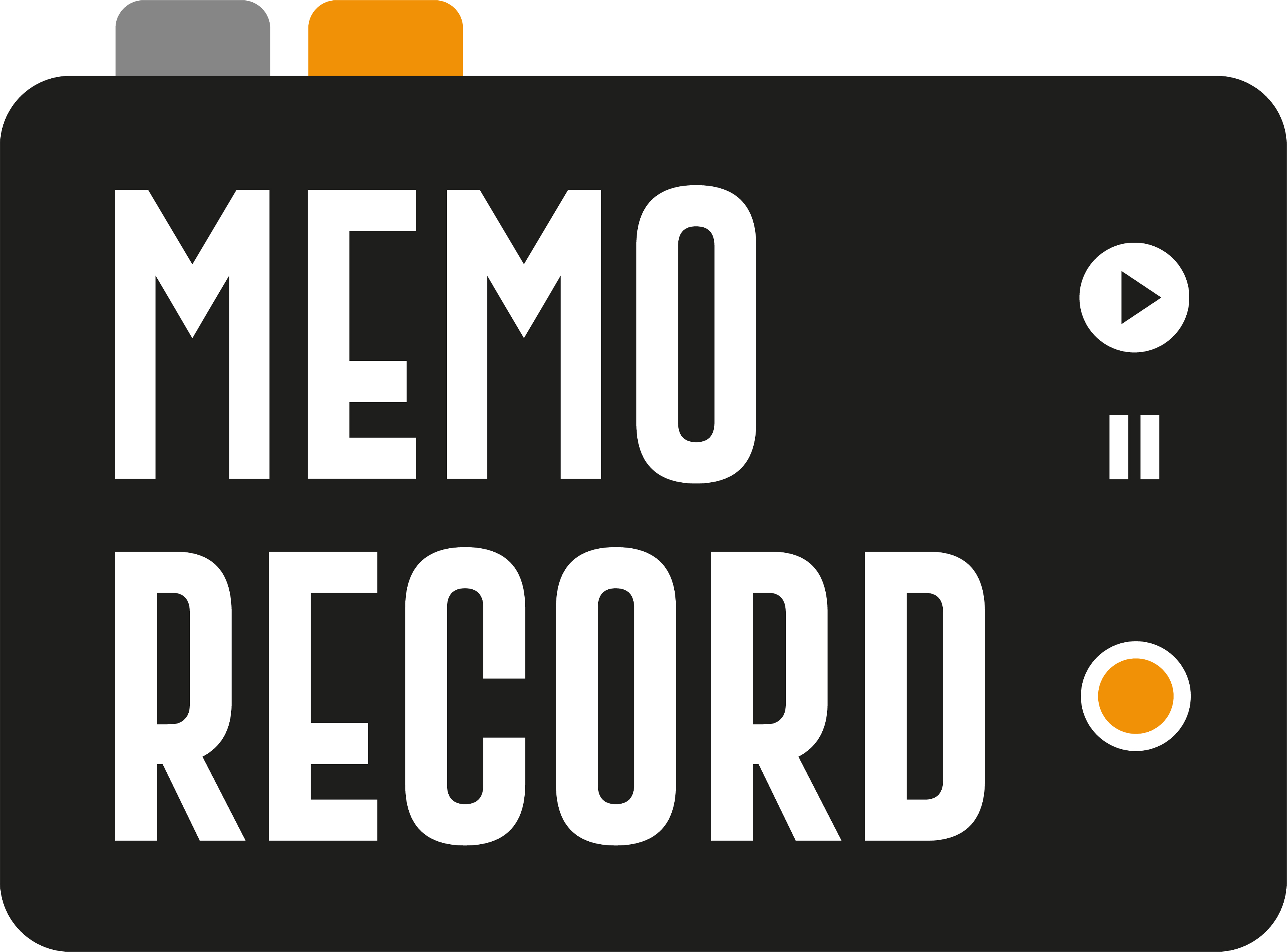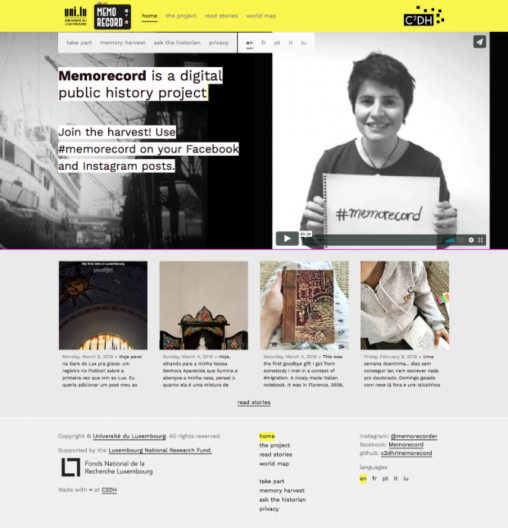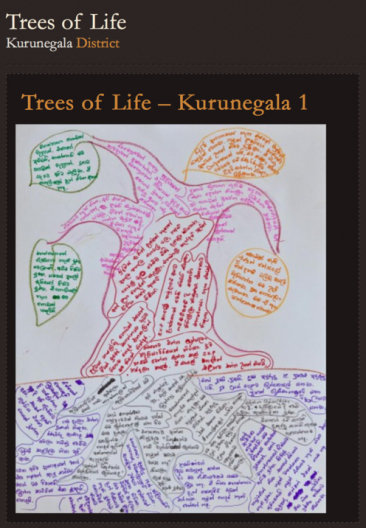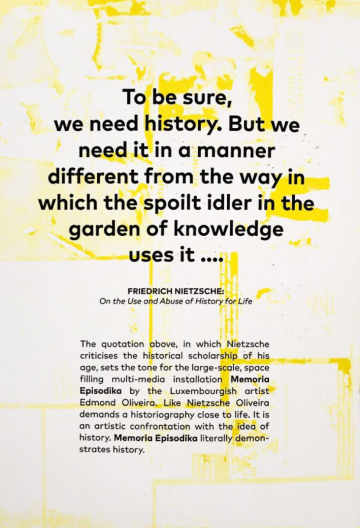Here, some personal stories and reflections on why I believe the crowdsourcing experiment I am conducting for my PhD research can contribute to this idea, reconciling historiography with inventiveness, poetic creation, sonority and other forms of human expression often undervalued, both as source and as outputs, in the historiographical operation.1
The following text was originally written for the blog of the Collège Doctoral Trinational
[If you wish, enjoy your reading in the loop of Os Tincoãs, Deixa a Gira girar (edit j g b), on the EP 1Löffelchen, released on August 22, 2016.]2

#memorecord's first memory harvest day, in the context of the expo “Memória Episódika”. Espace H²O, Differdange, 20 May 2018.
Ten years ago, while in Italy for an academy exchange, I wrote an e-mail to my former supervisor in Brazil to share what at the time I called a crazy idea for a research project:
The [research] idea is the following: I will try to explain it in a general way, because it is something still very deformed and I must refine it a lot to be able to call it a "research project" with head and foot [a Brazilian expression that stands for coherent], but my intention is to work with historiography. My ambition is to study the problems of contemporary historiography through the presence/use of the World Wide Web in the academic environment – research, production, and dissemination of knowledge – also considering its performance outside the digital medium. [I would like to do that] to analyse the transformations, which had already occurred and that were still in progress in the historian's métier by the end of the 20th and beginning of the 21st Century. I know this is a very rough idea of the subject, and that's why I still prefer to see it as a kind of "umbrella theme." My current activity regarding this research is building a theoretical base of the subject (pre-web historiography, and post-web historiography/importance and range of the historian's actions as an intellectual before and after the web). Also, I need to get maturity and confidence in the subject to choose a single object to develop my study. I tend to lean towards a more in-depth analysis of the historian in the 21st Century through the novelties of communication, storage, and conservation of information with the advent of the Internet. In the wake of these issues, however, disconnected it may seem, there is my interest in Memory. (personal archive)
Back in April 2008, when I wrote this e-mail, I was an undergraduate student approaching digital history for the first time. The idea was born after a serendipitous discovery: a book about Storiografia Digitale (UTET Libreria, Ed. by Dario Ragazzini, 2004), that, after some switch and turns of life, brought me to meet Serge Noiret. Re-reading my e-mail to Prof. Manoel Luiz Salgado Guimarães today, I realised how much of the original idea is still there in my current projects. Funny enough, my path from the Bachelor studies until this PhD, looking at digital public history and memory, really seemed, at some point, disconnected. During my Masters, I was focusing on the writing of history and did not have enough time and space to reflect on memory more profoundly.
Just now, after launching the #memorecord memory harvest last weekend, in the context of an exhibition that discusses the episodic character of memories, I allowed myself to take a step back and look at the big picture3. Accidentally (or not), and here is the funny bit of this little story, visiting Memória Episódika before starting the preparation for the workshop #Memorecord – une récolte des mémoires. Quelle est la valeur d’une histoire ?, I found myself traveling back through my own episodic memories. The sweet taste of irony! Or just a clear confirmation that René Kockelkorn was tackling a fondamental point in his text for the exhibition's catalogue “Different from what might be expected, the exhibition is not centered on the artist’s Self but aims at the Self of the spectator. […] Oliveira is playing with the subjectivity of memory – always incorporating the present state of feeling/perception”.
The subjectivity of memory is also at the center of the crowdsourcing experiment I am conducting via Facebook and Instagram under the hashtag #memorecord. More information can be found on the official project website: www.memorecord.uni.lu.4
Crowdsourcing memories in the digital age
- 1. Senta que lá vem a história (“Go grab a seat, cause there’s a story coming”), expression in the title, was the phrase that opened the homonym sketch of the Brazilian children’s TV show Rá-Tim-Bum. The show was originally screened between 1990 and 1994 in the channel TV Cultura, in Brazilian public TV. The vignette remained a catchphrase in the popular imaginary of a particular generation even after the show was extinct, being used in a playful way when someone starts to tell a long story.
- 2. Originally, Deixa a gira girar was a popular theme of umbanda’s terreiros in Brazil and was recorded by Os Tincoãs, in its debut album, of 1973. The sound of the group was deeply immersed in the candomblé, umbanda, capoeira, samba, and everything related to Afro-Brazilian culture. Undoubtedly, the time-space of Afro-Brazilian encounters and rituals is a fertile ground of inventiveness, syncretism, respect, empathy, colors, and sonorities that speak simply about the great challenges and beauties of life, in a way accessible to doctors and students, to recall a fundamental premise of teaching history according to Marc Bloch. As the Carioca historian Luiz Antonio Simas uses to say, all this is part of the “epistemology of macumba," and much of this popular knowledge is passed from generation to generation through oral tradition, especially through storytelling, music, and rhythms. I thought it would make sense to offer the remix of the track at the top of the text, having in mind how a remix is a reinventing power, at the same time a transgression and a re-reading/reinterpretation exercise. A message of freedom, an appeal to open our ears. Saravá!
- 3. Or shall I say, to be honest, that it was a coincidence that drove me back to the events in Florence, and helped me to reconnect to this Ariadne's thread? Actually, the day of the first offline activity of my PhD project – 20th of May – happens to be the very same day when years ago, some weeks after sending the e-mail above quoted, I was going public with my first digital creature, the blog Historiografia na Rede. I could not be happier having the Memorecord’s kickoff on the 10th anniversary of my blog! My debut in the terrains of digital research! I am touched by this whole recollection, and I am genuinely thankful to Edmond Oliveira and his inspiring artwork at Memória Episódika, that allowed me to see the synergy through these events. Villmols merci, Edmond!
- 4. Kudos to Daniele Guido, lead designer at C²DH, for his infinite patience and creativity, that made it possible to translate my ideas into this beautiful, communicative design!
The soul of this crowdsourcing adventure is community participation. The idea behind it is simple: in the digital age, many of us are virtually transporting our memory boxes to the digital platforms. Family albums, treasured objects, old letters, diaries, all sorts of mementos that used to be in the bottom of a trunk, in the corner of the attic or in a shoebox somewhere in the closet, are now taking the form of digital objects. Thanks to new technologies of memory1, such as digital photo cameras, camcorders, mobile devices and computers in general, memory practices and sharing rituals are changing. At the same time, the web is enabling unprecedented forms of communication between Academia and society, both regarding science communication and research methods. However, this scenario can still be blurry due to the velocity of all the changes in this transitory process from the complete analogue to the digital, or more hybrid realities.
Re-thinking about the earlier e-mail, I see clearer now that my research tries to cope with some elements of this transition that have been intriguing me for a long time. Considering that memory is one of the principal matters in the history workshop, if the dynamics around it changes, the historian's craft will, likewise, be altered, and new approaches may unfold from the necessity to deal with these novelties. I am very much interested to see how the practices around the dynamics of memories in the digital age can affect historiography. The new media specialist José van Dijck rearticulated the notion of mediation of memories into the more dialectic conceptual tool of mediated memories, “not only to account for the intricate connection between personal collections and collectivity but also to help theorize the mutual shaping of memory and media”2. With this concept in mind, I designed the research methods for my thesis – Shaping a digital memory platform on migration narratives: A public history project on migration memories in Luxembourg (original proposal) – as an original experiment of historical crowdsourcing.
The central idea of this PhD research methods was applying digital tools to gather and analyse different sources, visualize, and present them the to both the academic community and the general public. Part of the sources for this research is based on oral history interviews, but alongside this well-established way of doing history, I am also exploring a more slippery terrain through the interdisciplinary journey that the crowdsourcing has turned out to be so far. However, the risks that are taken here (i.e., challenges to engage the community, technical limitations, ethical implications, the need to develop a new way to analyse the materials gathered, etc.) seem worthy in relation to the epistemological gain it can bring. In terms of methodology and theory, with the memory harvest proposed with #memorecord, I aimed at:
- widening and diversifying the sample of the research participants – potentially adding new voices to the research;
- liberating participants from the indispensable, direct, interaction with me – potentially leaving more room for their subjectivity;
- taking into account the technological development and the role of private and public interplay in the sharing dynamics of the web – potentially enabling the analyse of the mutual shaping of memory and media;
- approaching memories in prompt, fragmented way – potentially discharging historiography from the paradox of working with memories through data types that instead present them as an orderly, coherent unit whereas, most of the time, outside the academic environment, in everyday life, memories are evoked in a circumstantial way, more often in a crumbled, granulated fashion than in the form of a logical narrative;
For a historiographical conversation
My bet on a data collection model that takes advantage of digital technology to get closer to the people, outside the University walls, is making this collaborative way of gathering data into an argument in itself. Since the very first sketch of this project about migration memories in Luxembourg, it was deliberated choice bring these digital related issues to the radar of history of historiography too. In line with the recent white paper by the Roy Rosenzweig’s Center For History and New Media (RRCHNM), on Digital History and Argument, by implementing this experimental approach, I wanted to establish a conversation with the rest of the profession, potentially fostering an exchange with them that would collaborate on showing how digital methods can help the historical discipline to elaborate and answer new questions.
All this could perhaps sound too ambitious for a PhD project, but revisiting my ideas from a decade ago, I can only see this as a reshaping of the initial questioning behind my e-mail to Prof. Manoel, another part of the big puzzle I am facing in my academic journey. As a teacher and as a researcher, I retain it is essential to fulfill this need for experimentation, even if this speculative approach may sound too perilous at this stage of my career. As my supervisor, Prof. Dr. Andreas Fickers keeps remembering me, doing science is about creating uncertainty.
I believe uncertainty is of high relevance to historiography, a field that on the one hand endorses itself by the rigor of well-established norms of source criticism and research practices, but on the other side, also finds itself entangled in longstanding "disciplinary inertia," to use an expression suggested by François Hartog3.
For me, opening my research to a broader range of sources, including audio, visual, material and born digital objects through this crowdsourcing experiment goes in the direction of what the Brazilian historian Durval Muniz Albuquerque Junior said about the reconciliation of historiography with the voice, with the effects of the voice over the body, taking voice as an element to expand historiographical boundaries to other realms, flirting with other cultural forms, such as cinema, literature, theatre, but also folk, craftwork, popular music, and so on. Accordingly, Hans Ulrich Gumbrecht calls attention to an approach that could try to approximate the historical “climate”, the historical Stimmung, to a sophisticated kind of resource, analogue to the local color in literature. For Gumbrecht, this could enable us to grasp the atmosphere of a given moment; in another interpretation, closer to that of Albuquerque Junior, this could lead us back to the voice of a particular historical moment, the voice of a culture4. In such a move, Albuquerque Junior wrote, reflecting on how this openness could enrich Brazilian historiography:
Historiography would reconcile its links with rhetoric, paying attention to, and being part of the voice of our time. A time when ears return to the historian as much as the eyes. Historiography, which intended to show the past, may now have to listen to it. If it is a time of disenchantment, perhaps the historiography needs to be singing, music, sound landscape, ambience, the mood of ideas. To affect men both by concepts and by aesthetic effects. To be not just logos, but mythos and rituals. Not only erudition, normativity, and rigor in the German fashion, but perhaps inventiveness, poetic creation and sonority in a Brazilian way.5
When it comes to my positioning as a researcher working on migration memories in Luxembourg, I might admit that I have also brought some disciplinary memories from Brazil. Perhaps it is embedded in the Brazilian historiographical debate on the possibility of learning from history, in which Albuquerque Junior raises his reflections that I tend to be in favor of crossing disciplinary boundaries, borrowing concepts, tools and lens that can help me to adapt my way of writing history accordingly to the conditions of history production in my very research context.
In Luxembourg, the national branding around the successful story of migration in the country fascinates me. However, after conducting a dozen of interviews in the traditional one-to-one format, I realised that the crowdsourcing I have planned in the research proposal would be, indeed, fundamental to the study. I came to this conclusion after observing, in the first year, that in the one-to-one setting, I was encountering accounts that were already reproducing a specific narrative frame, which I could perceive even from a small sample6. Therefore, in the process of shaping this digital memory platform, that went public in the final form of #memorecord on this May 2018, I found myself, many times, updating the design of the gathering mechanism to make it as open and democratic as possible. The very first draft was a portal where participants could upload their contents, very much inspired by digital and public history initiatives like the Museu da Pessoa (Brazil), the Bracero History Archive (US/Mexico) or the Hurricane Digital Memory Bank (US) developed by the RRCHNM. But after two designs and layout tries, I realised it could be still very much limited in terms of sensitising and engaging a community around the project. Then, in the remix mood of the soundtrack I suggested at the beginning of this post, I re-conceptualised the crowdsourcing process. But, this time, having existent social media (Facebook and Instagram) as the primary engine for the social activation. It is not by chance that this conceptual model reconnects with a workflow I knew well from the time I worked as a public historian to the Instagram collaborative photo-documentaries @Rio450 and @Rio365 [2013 – 2015] - both projects that engaged over 6 thousand participants at that time.
Nevertheless, the idea of collecting migration memories through the project hashtag would not resolve all my concerns for securing the most plural participation as possible. The technology that allowed me to plan such a data collection through the web, is the very same installing a divide in the project, limiting its range to those who /are members of social media networks. Hence my decision to soften the digital borders of the platform and dilute this in a more holistic form of participation that integrates offline opportunities, like the one at Edmond’s exhibition, for the public to get to know me/the project and vice-versa. Consequently, this makes room for other types of engagement as well as type of sources to be collected. In this line, one of my main inspirations was the Sri Lankan community project Herstories, which as #memorecord, was set at the crossroads of oral, digital and public history practice, with loads of sensory ethnography7 on the background.
I already knew Herstories (I wrote about it here) when I met its curator, Radhika Hettiarachchi, for the first time. It was in the context of the International Oral History Conference, in India, in 2016. By then, I was already an enthusiast of the initiative, but it was only after seeing, in person, some sheets drawn by the women who took part in the project that I understood how important it was that the creators thought about providing some room for encounters and exchanges amongst participants. In Bengalore, Radhika was exposing some documents and part of the artwork integrated into her collection. Letters, lifetrees, timelines and graphic art helped the curator to get closer to the community and build a common language to the project, that was dealing with different ethnicities, and different languages in a post-war context. However, by paying profound respect to their subjectivity, Herstories paved the way for the success of the project’s performance, achieving what is for me one of the most fundamental assets of working with history: enabling empathy.
- 1. House, Nancy Van, and Elizabeth F. Churchill. “Technologies of Memory: Key Issues and Critical Perspectives.” Memory Studies vol. 1, no. 3 (September 1, 2008): 295–310.
- 2. Dijck, Jose van. Mediated Memories in the Digital Age. Stanford, Calif: Stanford University Press, 2007.
- 3. Hartog, François. El historiador en un mundo presentista. In: Devoto, Fernando (Dir.). Historiadores, ensayistas y gran publico: la historiografia argentina 1990-2010. Buenos Aires: Editorial Biblos, 2010.
- 4. Gumbrecht, Hans Ulrich. Depois de “aprender com a história”, o que fazer com o passado agora? In: Nicolazzi, Fernando; Mollo, Helena Miranda; Araujo, Valdei Lopes de (Org.). Aprender com a história? O passado e o futuro de uma questão. Rio de Janeiro: Editora FGV, 2011. p. 25-42.
- 5. Albuquerque Junior, Durval Muniz de. [book jacket] In: Nicolazzi, Fernando; Mollo, Helena Miranda; Araujo, Valdei Lopes de (Org.). Aprender com a história? O passado e o futuro de uma questão. Rio de Janeiro: Editora FGV, 2011.
- 6. I am very grateful to Dr. Adrien Thomas, from the Luxembourg Institute of Socio-Economic Research for his observations regarding this specific bias on my research plan. His commentary on my work during my presentation at the Atelier d’histoire, organized by the Uni.lu’s Institute for Historyin March 2017, was fundamental to make me rethink my strategies.
- 7. Pink, Sarah. Doing Sensory Ethnography. SAGE, 2009.
I believe the words of the Nigerian writer Chimamanda Ngozi Adichie, quoted in the session About Us, in the Herstories’s website are profoundly eloquent there:
Stories matter. Many stories matter. Stories have been used to dispossess and to malign, but stories can also be used to empower and to humanize. Stories can break the dignity of a people, but stories can also repair that broken dignity.
Maybe it was my Brazilian baggage playing a role again when I tuned #memorecord in this synergy with Herstories. Some years ago, thanks to Dr. Giovana Xavier who I had as a lecturer in Rio, I got to know the work of Chimamanda, many years before meeting Radhika. My first contact with Chimamanda was through this TED talk (2009), in which she introduces herself as a storyteller, and guide us through her personal stories about the “danger of a single story”. Chimamanda’s message underlines the importance of not portraying a single story to fight hate speech, racism, and many forms of prejudice and stereotypes. Chimamanda’s talk stresses the importance of learning and understanding other stories to empower people in their struggle for social justice. From my perspective, that TED talk video was one of the most sturdy materials Giovana brought to the classroom as a trigger to kick off our theoretical discussions. On that day, she wanted to draw attention to the constructed character of the historical narrative, emphasising the importance of acknowledging the agency of all the different actors in the historical processes, watching out for the representativeness of their experiences in the sources.
The work of these three women around the globe – Brazil, Nigeria, Sri Lanka – had, for various reasons, a particular weight in the research positioning I adopt in Luxembourg. Theoretically, it resonates in my public history inspiration for the thesis. My approach is built on the concept of shared authority. This concept, prized by oral history and public history practitioners, was developed by Michael Frisch in the 1990’s1. It might be under different lanes, but one can say it is also expressed in the work of Giovana, Chimamanda, and Radhika. In a simple definition, shared authority informs us about the fact that experts in historical institutions and the public share the interpretation processes with no-hierarchical distinctions. It reclaims no special authority for historians, although, of course, we keep being members of a disciplinary community with rigorous methodological and theoretical rules to follow. In other words, acknowledging the existence of a shared authority does not mean a loss of value of the historian's craft, but should boost our capacity to embrace other subjects' savvy in their ways of telling their stories, passing them on, preserving and interpreting them, as well as to account their historical agency. Therefore, it is on purpose that I opened my project's memory harvest to everybody to take part. One of the central questions #memorecord wants to answer is “What is behind and beyond the successful story of migration in Luxembourg?”. The more people participate, the more diverse our collection and the more wide-ranging and democratic our answer can be.
I know the present stage is only the beginning of the journey for the #memorecord platform. However, after the first exchanges on this 20th May, I can already say this project is a step further in the direction of what I believe digital public history should look like. Thanks to the memory harvest workshop, fifteen people with different family backgrounds (Italy, Portugal, Cape Verde and Luxembourg), met last Sunday and shared their memories with each other, confronted, for instance, with the diversity of perspectives among the generations. The exchange was vibrant and not only helped me to collect some data to my research but had a direct effect on the way participants see each other and perceive themselves in Luxembourg's society. A detailed reflection on this first workshop deserves a separate blog post. For now, I wanted to share that I believe, borrowing René Kockelkor's idea on the catalogue for Edmond's expo, that this memory harvest can be a step towards a historiography closer to life.
- 1. Frisch, Michael. A Shared Authority: Essays on the Craft and Meaning of Oral and Public History. SUNY Press, 1990.







